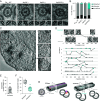Microtubule inner proteins of Plasmodium are essential for transmission of malaria parasites
- PMID: 39908102
- PMCID: PMC11831158
- DOI: 10.1073/pnas.2421737122
Microtubule inner proteins of Plasmodium are essential for transmission of malaria parasites
Abstract
Microtubule inner proteins (MIPs) are microtubule-associated proteins that bind to tubulin from the luminal side. MIPs can be found in axonemes to stabilize flagellar beat or within cytoplasmic microtubules. Plasmodium spp. are the causative agents of malaria that feature different parasite forms across a complex life cycle with both unique and divergent microtubule-based arrays. Here, we investigate four MIPs in a rodent malaria parasite for their role in transmission to and from the mosquito. We show by single and double gene deletions that SPM1 and TrxL1, MIPs associated with subpellicular microtubules, are dispensable for transmission from the vertebrate host to the mosquito and back. In contrast, FAP20 and FAP52, MIPs associated with the axonemes of gametes, are essential for transmission to mosquitoes but only if both genes are deleted. In the absence of both FAP20 and FAP52, the B-tubule of the axoneme partly detaches from the A-tubule, resulting in the deficiency of axonemal beating and hence gamete formation and egress. Our data suggest that a high level of redundancy ensures microtubule stability in the transmissive stages of Plasmodium, which is important for parasite transmission.
Keywords: Plasmodium; malaria transmission; microtubule inner proteins.
Conflict of interest statement
Competing interests statement:The authors declare no competing interest.
Figures




Similar articles
-
Proteomes of plasmodium knowlesi early and late ring-stage parasites and infected host erythrocytes.J Proteomics. 2024 Jun 30;302:105197. doi: 10.1016/j.jprot.2024.105197. Epub 2024 May 15. J Proteomics. 2024. PMID: 38759952 Free PMC article.
-
Plasmodium falciparum PP1 phosphatase is a key regulator of malaria parasite transmission.mBio. 2025 Aug 18:e0087425. doi: 10.1128/mbio.00874-25. Online ahead of print. mBio. 2025. PMID: 40823845
-
Larvivorous fish for preventing malaria transmission.Cochrane Database Syst Rev. 2013 Dec 10;(12):CD008090. doi: 10.1002/14651858.CD008090.pub2. Cochrane Database Syst Rev. 2013. Update in: Cochrane Database Syst Rev. 2017 Dec 11;12:CD008090. doi: 10.1002/14651858.CD008090.pub3. PMID: 24323308 Free PMC article. Updated.
-
The Plasmodium falciparum homolog of Vps16 interacts with the core members of the Vps-C tethering complex.mSphere. 2025 Jul 29;10(7):e0028725. doi: 10.1128/msphere.00287-25. Epub 2025 Jul 8. mSphere. 2025. PMID: 40626728 Free PMC article.
-
Primaquine for reducing Plasmodium falciparum transmission.Cochrane Database Syst Rev. 2012 Sep 12;(9):CD008152. doi: 10.1002/14651858.CD008152.pub2. Cochrane Database Syst Rev. 2012. Update in: Cochrane Database Syst Rev. 2014 Jun 30;(6):CD008152. doi: 10.1002/14651858.CD008152.pub3. PMID: 22972117 Updated.
Cited by
-
Evolutionary adaptations of doublet microtubules in trypanosomatid parasites.Science. 2025 Mar 14;387(6739):eadr5507. doi: 10.1126/science.adr5507. Epub 2025 Mar 14. Science. 2025. PMID: 40080577 Free PMC article.
References
-
- Nicastro D., et al. , The molecular architecture of axonemes revealed by cryoelectron tomography. Science 313, 944–948 (2006). - PubMed
MeSH terms
Substances
Grants and funding
LinkOut - more resources
Full Text Sources
Medical
Miscellaneous

